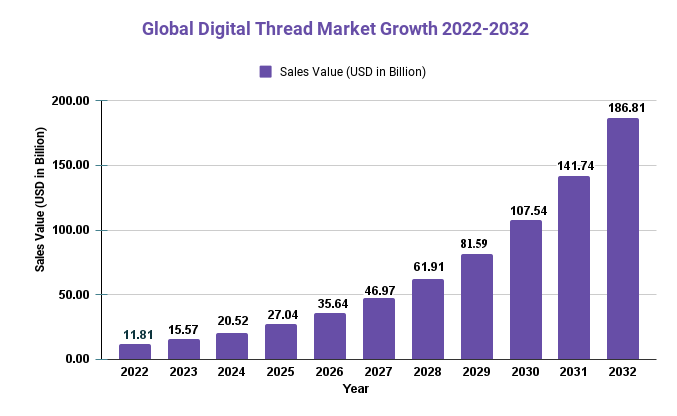Digital Thread Market Research Findings and CAGR of 31.8% by 2032

Page Contents
Market Overview
Published Via 11Press: The global Digital Thread market was experiencing strong growth and was expected to continue to do so in the coming years. The Digital Thread market refers to the use of digital technology to create a seamless thread of information throughout the product lifecycle, from design to manufacturing to maintenance and beyond. The market includes software, hardware, and services that enable companies to manage and analyze this information and optimize their operations.
According to a report by Market.us, the global Digital Thread market size was valued at USD 11.81 billion in 2022 and was expected to grow at a CAGR of 31.8% from 2022 to 2032.
Overall, the Digital Thread market is expected to continue to grow rapidly in the coming years, driven by the increasing adoption of Industry 4.0, advancements in digital technology, and a growing focus on product lifecycle management.
Request For Sample Report Here@ https://market.us/report/digital-thread-market/request-sample

Regional Snapshot
- North America was the largest global market for Digital Thread Solutions, accounting for a substantial share of the global marketplace. The dominance of the region is due to the presence of several large technology companies as well as a highly developed industrial sector. The United States is a significant market for Digital Thread solutions. Numerous companies are investing in Industry 4.0 initiatives, and using digital technologies to enhance their operations.
- Europe was also a large market for Digital Thread solutions. France, Britain, and Germany were the leaders. Digital Thread solutions are being sought after due to the strong regional manufacturing sector and emphasis on Industry 4.0 initiatives.
- Asia-Pacific was home to the fastest-growing market in Digital Thread solutions. Countries such as South Korea, Japan, and China were driving growth. Digital Thread solutions have been in high demand due to the region's growing and dynamic manufacturing sector as well as government initiatives for digitalization.
- Others regions like Latin America, Africa, and the Middle East are also expected to experience growth in the Digital Thread Market, though at a slower rate than the major markets. The growing industrialization of these regions and the rising demand to automate are driving demand for Digital Thread solutions.
Drivers
- Adoption of Industry 4.0: The rise of Industry 4.0, or the use of digital technology to revolutionize manufacturing and other industries, is a major driver in the Digital Thread market. Companies are utilizing this technology for the optimization of operations, increased efficiency, and cost reduction.
- Focus on Product Lifecycle Management: Companies are placing greater emphasis on controlling every step of a product's lifespan, from design to maintenance. Digital Thread technology gives companies the power to create one centralized source of truth for product data which allows them to make better decisions and enhance their products.
- Advancements in Digital Technology: New advancements in digital technologies such as the Internet of Things (IoT) and artificial intelligence (AI) are providing new applications for Digital Thread technology. For instance, IoT sensors can be utilized to collect data throughout a product's lifespan, while AI analyzes this data and optimizes operations accordingly.
- Cloud Computing Adoption: The growing adoption of cloud computing is making it simpler and more cost-effective for companies to implement Digital Thread solutions. Cloud-based platforms enable companies to access their data remotely, collaborate with partners and suppliers, and scale operations as needed.
- Government Initiatives to Foster Digitalization: Governments around the world are actively encouraging their economies to move into the digital realm, with Digital Thread technology playing a pivotal role. Through initiatives such as Industry 4.0 initiatives, governments are encouraging demand for Digital Thread solutions.
- Need for enhanced Visibility and Control: As products become more intricate, companies face increasing difficulties managing the data associated with them. Digital Thread technology enables companies to create a single source of truth for product data, giving them greater insight and oversight throughout the entire product lifecycle.
Restraints
- Implementation Costs: Adopting Digital Thread technology can be costly, particularly for small and medium-sized enterprises (SMEs) that may not have the resources to invest in new equipment. This poses a significant obstacle to adoption and may slow the market's expansion.
- Complex Integration: Adopting Digital Thread solutions often necessitates integration with existing systems, which can be time-consuming and complex. This could cause delays and additional expenses, further impeding the adoption of the technology.
- Data Security Concerns: As companies collect and share more data throughout their product lifecycle, security, and privacy worries are increasing. Companies need to guarantee their data is secure and protected at all costs, which may add extra complexity and expense when implementing Digital Thread solutions.
- Lack of Skilled Professionals: Adoption of Digital Thread technology requires highly experienced individuals with knowledge in data analytics, cloud computing, and cybersecurity. Unfortunately, there is currently a shortage of professionals with these abilities which may restrict its adoption.
- Resistance to Change: Adopting Digital Thread technology necessitates changes in organizational processes and culture that may prove challenging. Resistance to change can hinder the adoption of the technology and slow market expansion.
Opportunities
- Increased Adoption in Small and Medium-Sized Enterprises: While large enterprises have been among the early adopters of Digital Thread technology, there is an exciting potential to increase adoption among smaller firms. As costs associated with implementing solutions decrease and advantages become more widely understood, SMEs could become an increasingly important market for this cutting-edge platform.
- Expansion into New Industries: Although the initial focus of Digital Thread technology has been on manufacturing and aerospace industries, its advantages could potentially be applied in other sectors such as healthcare, construction, or transportation. As more people become aware of its advantages, there may be new applications and markets available for it.
- Integration with Emerging Technologies: Digital Thread technology can be integrated with other rapidly developing technologies like artificial intelligence, blockchain, and 5G networks, creating new applications and use cases. As these technologies continue to advance and mature, there may be significant chances for Digital Thread technology to spur innovation and economic growth.
- Real-Time Data Demands Rise: As real-time data and analytics become more commonplace, so does the demand for Digital Thread technology. This can offer crucial insights into a product's performance and operational efficiency. There may be an increasing need for solutions that provide real-time data as businesses strive to enhance their processes and products.
- Focus on Sustainability Growing: Organizations are placing more of an emphasis on sustainability and minimizing their environmental impact, so Digital Thread technology can help streamline processes and cut waste. There may be an uptick in demand for solutions that help businesses increase their sustainability levels while decreasing their environmental footprint.
View Detailed TOC of the Report | https://market.us/report/digital-thread-market/table-of-content/
Challenges
- Lack of standards: Currently, there is no widely accepted standard for Digital Thread technology, which can make it difficult for companies to implement and integrate solutions from different vendors. The lack of standards can also lead to issues with interoperability, data sharing, and data security.
- Data complexity and quality: Digital Thread technology requires the integration of data from multiple sources throughout the product lifecycle. Ensuring the quality and consistency of this data can be a challenge, particularly when dealing with legacy systems and processes.
- Cybersecurity risks: As Digital Thread technology involves the sharing and analysis of sensitive data, it is particularly vulnerable to cybersecurity threats. Ensuring the security and privacy of data throughout the product lifecycle is critical, and companies must be vigilant in protecting their systems and data.
- Cost and ROI: Implementing Digital Thread solutions can be expensive, particularly for smaller companies with limited resources. Demonstrating a clear return on investment (ROI) can be a challenge, particularly when the benefits of Digital Thread technology are difficult to quantify.
- Resistance to change: As with any new technology, implementing Digital Thread solutions can require significant changes to organizational processes and culture. Resistance to change can be a major challenge and can slow the adoption of the technology.
Key Market Segments
Type
- Parts Type
- System Type
Application
- Aerospace & Defense
- Automotive & Transportation
- Machine Manufacturing
- Energy & Utilities
- Others
Key Market Players
- General Electric
- PTC
- Siemens
- Dassault Systemes
- IBM Corporation
- ANSYS
- Microsoft Corporation
- Oracle Corporation
Report Scope
| Report Attribute | Details |
| The market size value in 2022 | USD 11.81Bn |
| Revenue forecast by 2032 | USD 186.81Bn |
| Growth Rate | CAGR Of 31.8% |
| Regions Covered | North America, Europe, Asia Pacific, Latin America, and Middle East & Africa, and Rest of the World |
| Historical Years | 2017-2022 |
| Base Year | 2022 |
| Estimated Year | 2023 |
| Short-Term Projection Year | 2028 |
| Long-Term Projected Year | 2032 |
Frequently Asked Question
Q: What is the current market size for the Global Digital Thread Market?
A: According to a report by Market.us, the Global Digital Thread Market was valued at USD 11.81 billion in 2022 and is expected to reach USD 186.81 billion by 2032, growing at a CAGR of 31.8% during the forecast period.
Q: What are the key segments of the Global Digital Thread Market?
A: The Global Digital Thread Market can be segmented based on Type (Parts Type, System Type), By Application (Aerospace & Defense, Automotive & Transportation, Machine Manufacturing, Energy & Utilities, Others), and geography (North America, Europe, Asia-Pacific, Latin America, and Middle East & Africa).
Q: Who are the key players in the Global Digital Thread Market?
A: Some of the key players in the Global Digital Thread Market include General Electric, PTC, Siemens, Dassault Systemes, IBM Corporation, ANSYS, Microsoft Corporation, and Oracle Corporation.
The team behind market.us, marketresearch.biz, market.biz and more. Our purpose is to keep our customers ahead of the game with regard to the markets. They may fluctuate up or down, but we will help you to stay ahead of the curve in these market fluctuations. Our consistent growth and ability to deliver in-depth analyses and market insight has engaged genuine market players. They have faith in us to offer the data and information they require to make balanced and decisive marketing decisions.